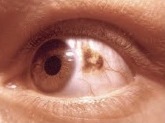
Photo from wikipedia
Purpose: To evaluate optical coherence tomography angiography (OCTA) characteristics of macular vascular details in eyes with choroidal nevus and melanoma, compared with unaffected contralateral eye. Methods: Retrospective comparative analysis comprising… Click to show full abstract
Purpose: To evaluate optical coherence tomography angiography (OCTA) characteristics of macular vascular details in eyes with choroidal nevus and melanoma, compared with unaffected contralateral eye. Methods: Retrospective comparative analysis comprising 70 patients with choroidal nevus and 36 patients with choroidal melanoma examined with optical coherence tomography angiography. Measurements included central macular thickness (CMT), superficial (sFAZ) and deep (dFAZ) foveal avascular zone (FAZ) area, and superficial (sCVD) and deep (dCVD) capillary vascular density (CVD). Results: In patients with nevus, CMT (affected vs. unaffected eye) was similar (267 vs. 265 &mgr;m, P = 0.67), whereas in patients with melanoma, CMT demonstrated greater thickness in affected eye (322 vs. 259 &mgr;m, P < 0.0001). In eyes with nevus, the FAZ (affected vs. unaffected eye) showed similar values in sFAZ (0.238 vs. 0.232 mm2, P = 0.72) and dFAZ (0.284 vs. 0.271 mm2, P = 0.48). In eyes with melanoma, similar values for sFAZ (0.249 vs. 0.260 mm2, P = 0.73) were noted, whereas dFAZ was larger in the affected eye with macular melanoma (0.530 vs. 0.252 mm2, P = 0.012) and similar in eyes with extramacular melanoma (0.300 vs. 0.285, P = 0.75). Regarding CVD (affected vs. unaffected eye), eyes with nevus showed similar sCVD (54 vs. 53.9%, P = 0.81) and dCVD (60 vs. 59.4%, P = 0.19). Reduced dCVD was found in four eyes with nevus, all with three or more risk factors for growth (P < 0.01). In eyes with melanoma, significant reduction was found in both sCVD (50.5 vs. 53.1%, P = 0.006) and dCVD (56.6% vs. 59.8%, P = 0.0003). Reduction in sCVD was related to presence of subretinal fluid (P = 0.03). Reduction in dCVD was found with subretinal fluid presence (P = 0.003) or absence (P = 0.03), with both macular (P < 0.001) and extramacular (P < 0.001) melanoma, and with increasing tumor thickness (P = 0.005). Reduced dCVD was found in 11% of eyes with nevus versus 58% of eyes with melanoma (Chi-square test: 26.31; P < 0.0001). Conclusion: Compared with contralateral eye, eyes with choroidal nevus demonstrate similar CMT, FAZ, and CVD. In contrast, eyes with melanoma show increased CMT, enlarged FAZ, and reduced CVD, particularly related to increasing tumor thickness. Optical coherence tomography angiography could be a useful tool in differentiating choroidal nevus from melanoma.
Journal Title: Retina
Year Published: 2017
Link to full text (if available)
Share on Social Media: Sign Up to like & get
recommendations!